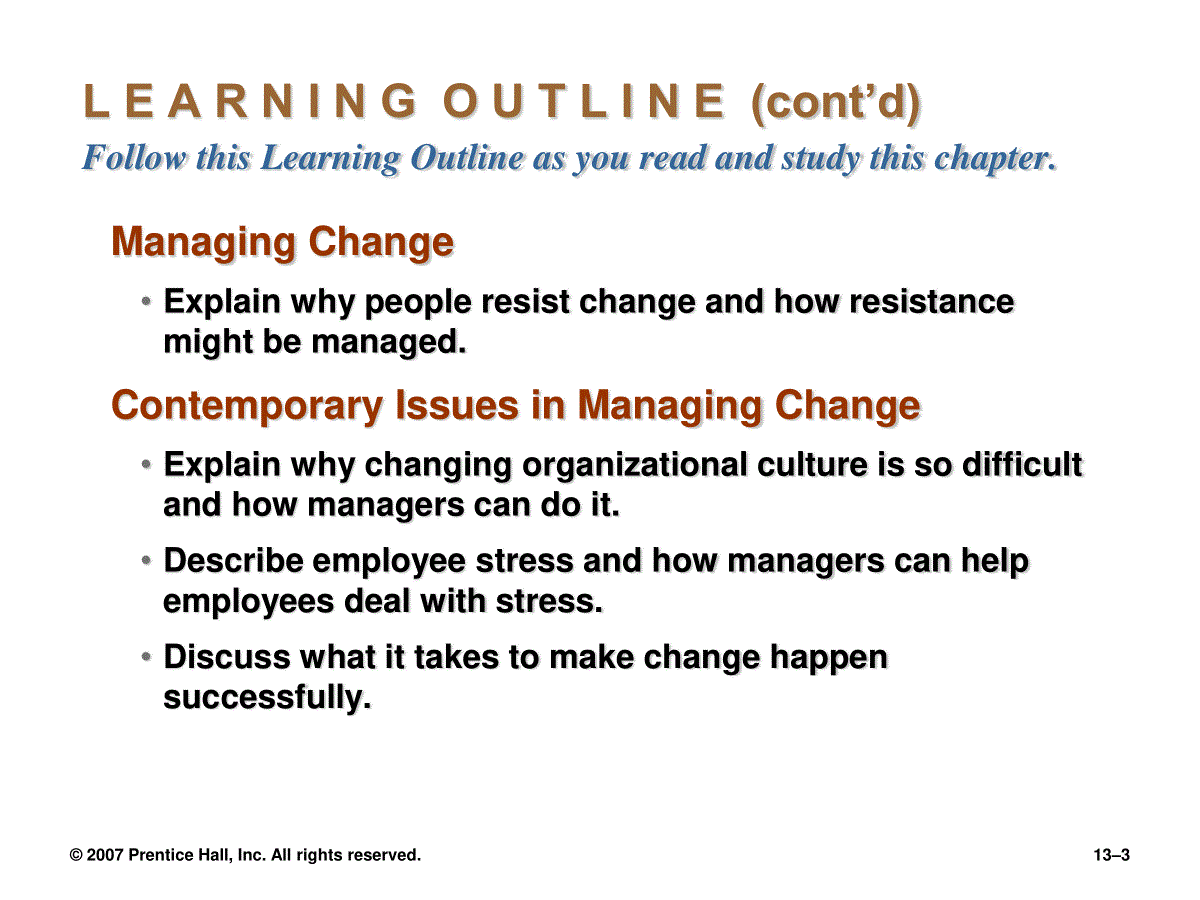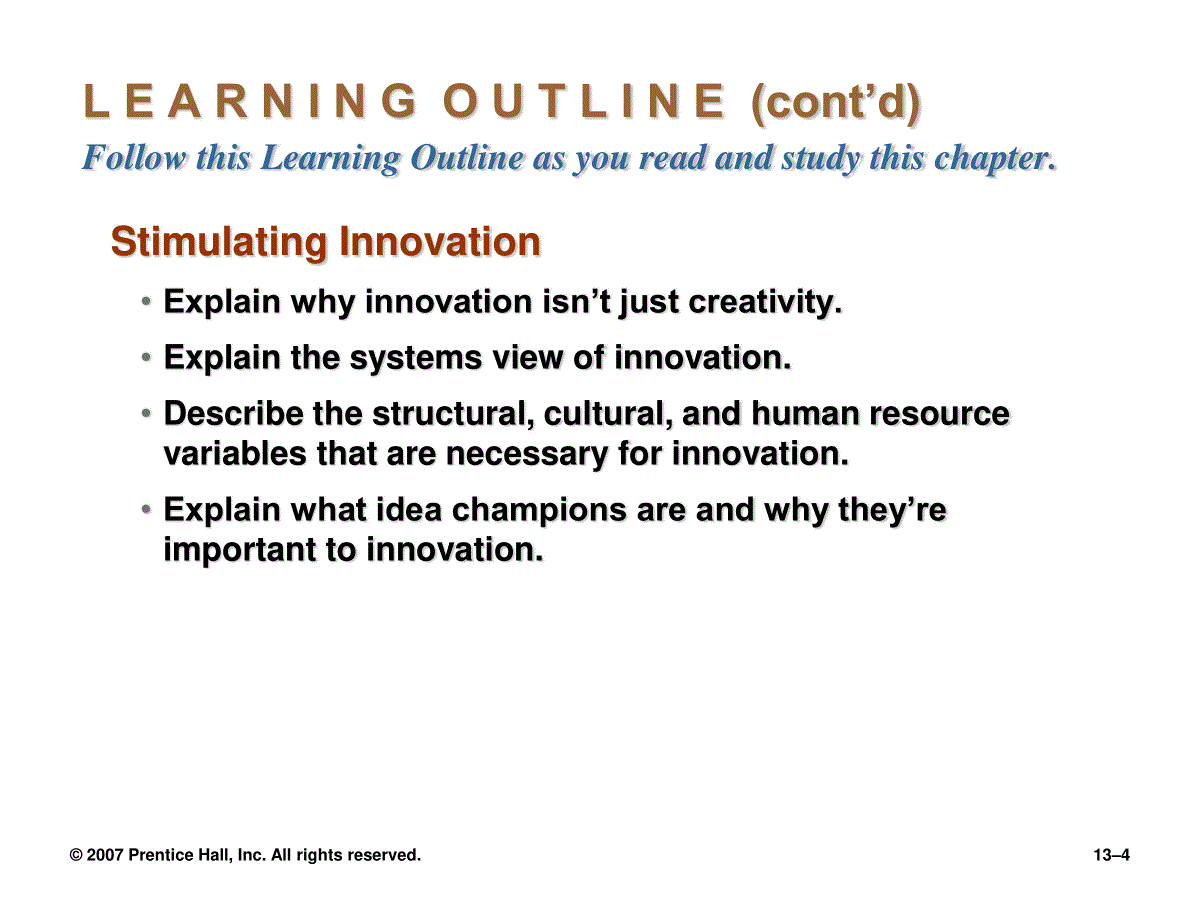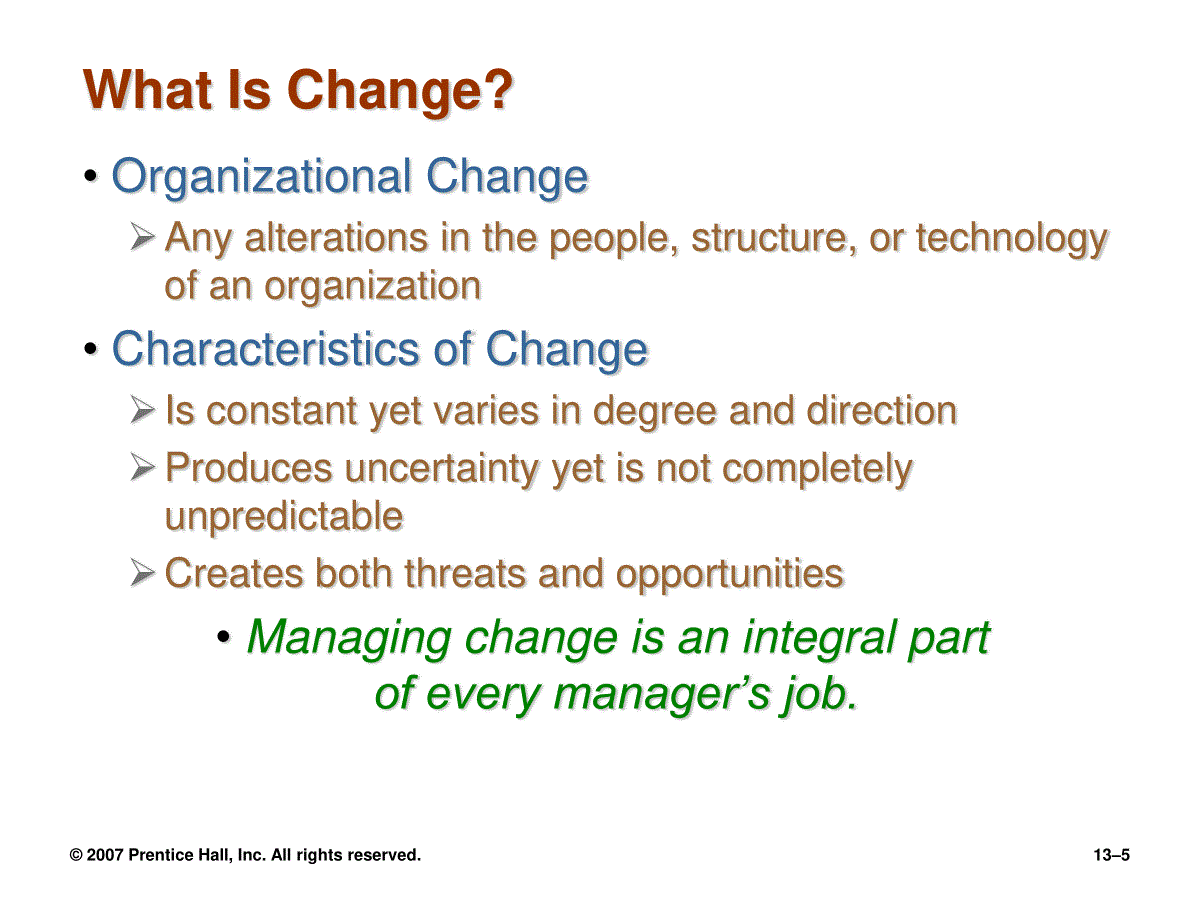当前位置:首页 > 商业/管理/HR > 项目/工程管理 > Managing Change and Innovation
nintheditionSTEPHENP.ROBBINSPowerPointPresentationbyCharlieCookTheUniversityofWestAlabamaMARYCOULTER©2007PrenticeHall,Inc.Allrightsreserved.ManagingChangeandInnovationChapter13©2007PrenticeHall,Inc.Allrightsreserved.13–2LEARNINGOUTLINEFollowthisLearningOutlineasyoureadandstudythischapter.ForcesforChange:TwoViewsoftheChangeProcess•Discusstheexternalandinternalforcesforchange.•Contrastthecalmwatersandwhite-waterrapidsmetaphorsofchange.•ExplainLewin’sthree-stepmodelofthechangeprocess.ManagingOrganizationalChange•Defineorganizationalchange.•Contrastinternalandexternalchangeagents.•Explainhowmanagersmightchangestructure,technology,andpeople.©2007PrenticeHall,Inc.Allrightsreserved.13–3LEARNINGOUTLINE(cont’d)FollowthisLearningOutlineasyoureadandstudythischapter.ManagingChange•Explainwhypeopleresistchangeandhowresistancemightbemanaged.ContemporaryIssuesinManagingChange•Explainwhychangingorganizationalcultureissodifficultandhowmanagerscandoit.•Describeemployeestressandhowmanagerscanhelpemployeesdealwithstress.•Discusswhatittakestomakechangehappensuccessfully.©2007PrenticeHall,Inc.Allrightsreserved.13–4LEARNINGOUTLINE(cont’d)FollowthisLearningOutlineasyoureadandstudythischapter.StimulatingInnovation•Explainwhyinnovationisn’tjustcreativity.•Explainthesystemsviewofinnovation.•Describethestructural,cultural,andhumanresourcevariablesthatarenecessaryforinnovation.•Explainwhatideachampionsareandwhythey’reimportanttoinnovation.©2007PrenticeHall,Inc.Allrightsreserved.13–5WhatIsChange?•OrganizationalChangeAnyalterationsinthepeople,structure,ortechnologyofanorganization•CharacteristicsofChangeIsconstantyetvariesindegreeanddirectionProducesuncertaintyyetisnotcompletelyunpredictableCreatesboththreatsandopportunities•Managingchangeisanintegralpartofeverymanager’sjob.©2007PrenticeHall,Inc.Allrightsreserved.13–6ForcesforChange•ExternalForcesMarketplaceGovernmentallawsandregulationsTechnologyLabormarketEconomicchanges•InternalForcesChangesinorganizationalstrategyWorkforcechangesNewequipmentEmployeeattitudes©2007PrenticeHall,Inc.Allrightsreserved.13–7ChangeProcessViewpoints•TheCalmWatersMetaphorLewin’sdescriptionofthechangeprocessasabreakintheorganization’sequilibriumstateUnfreezingthestatusquoChangingtoanewstateRefreezingtomakethechangepermanent•White-WaterRapidsMetaphorThelackofenvironmentalstabilityandpredictabilityrequiresthatmanagersandorganizationscontinuallyadapt(managechangeactively)tosurvive.©2007PrenticeHall,Inc.Allrightsreserved.13–8Exhibit13–1TheChangeProcess©2007PrenticeHall,Inc.Allrightsreserved.13–9ChangeAgents•ChangeAgentsPersonswhoactascatalystsandassumetheresponsibilityformanagingthechangeprocess.•TypesofChangeAgentsManagers:internalentrepreneursNonmanagers:changespecialistsOutsideconsultants:changeimplementationexperts©2007PrenticeHall,Inc.Allrightsreserved.13–10Exhibit13–2ThreeCategoriesofChange©2007PrenticeHall,Inc.Allrightsreserved.13–11TypesofChange•StructuralChanginganorganization’sstructuralcomponentsoritsstructuraldesign•TechnologicalAdoptingnewequipment,tools,oroperatingmethodsthatdisplaceoldskillsandrequirenewonesAutomation:replacingcertaintasksdonebypeoplewithmachinesComputerization•PeopleChangingattitudes,expectations,perceptions,andbehaviorsoftheworkforce•Organizationaldevelopment(OD)Techniquesorprogramstochangepeopleandthenatureandqualityofinterpersonalworkrelationships.©2007PrenticeHall,Inc.Allrightsreserved.13–12OrganizationalDevelopment•OrganizationalDevelopment(OD)Techniquesorprogramstochangepeopleandthenatureandqualityofinterpersonalworkrelationships.•GlobalODODtechniquesthatworkforU.S.organizationsmaybeinappropriateinothercountriesandcultures.©2007PrenticeHall,Inc.Allrightsreserved.13–13Exhibit13–3OrganizationalDevelopmentTechniques©2007PrenticeHall,Inc.Allrightsreserved.13–14ManagingResistancetoChange•WhyPeopleResistChange?TheambiguityanduncertaintythatchangeintroducesThecomfortofoldhabitsAconcernoverpersonallossofstatus,money,authority,friendships,andpersonalconvenienceTheperceptionthatchangeisincompatiblewiththegoalsandinterestoftheorganization©2007PrenticeHall,Inc.Allrightsreserved.13–15Exhibit13–4ManagerialActionstoReduceResistancetoChange•Educationandcommunication•Participation•Facilitationandsupport•Negotiation•Manipulationandco-optation•Selectingpeoplewhoacceptchange•Coercion©2007PrenticeHall,Inc.Allrightsreserved.13–16IssuesinManagingChange(cont’d)•ChangingOrganizationalCulturesCulturesarenaturallyresistanttochange.Conditionsthatfacilitateculturalchange:TheoccurrenceofadramaticcrisisLeadershipchanginghandsAyoung,flexible,andsmallorganizationAweakorganizationalculture©2007PrenticeHall,Inc.Allrightsreserved.13–17Exhibit13–5StrategiesforManagingCulturalChange•Setthetonethroughmanagementbehavior;topmanagers,particularly,needtobepositiverolemodels.•Createnewstories,symbols,andritualstoreplacethosecurrentlyinuse.•Select,promote,andsupportemployeeswhoadoptthenewvalues.•Redesignsocializationprocessestoalignwiththenewvalues.•Toencourageacceptanceofthenewval





 三七文档所有资源均是用户自行上传分享,仅供网友学习交流,未经上传用户书面授权,请勿作他用。
三七文档所有资源均是用户自行上传分享,仅供网友学习交流,未经上传用户书面授权,请勿作他用。
本文标题:Managing Change and Innovation
链接地址:https://www.777doc.com/doc-6188760 .html